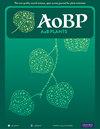附生凤梨的自交可补偿新热带山地森林中食蜜蝙蝠提供的有限授粉服务
IF 2.4
3区 生物学
Q2 ECOLOGY
引用次数: 0
摘要
具有专门传粉系统的植物经常表现出自花授粉的适应性,这种矛盾的情况可以用自花授粉的生殖保证功能来解释。在新热带地区,有几个植物种系依赖专门的脊椎动物传粉者进行有性生殖,其中包括种类繁多的凤梨科植物,它们也表现出自花授粉的倾向。到目前为止,关于自交在凤梨科和其他新热带植物群中的作用的证据还不多。为了深入了解自交在凤梨科植物繁殖系统中的进化和持续性,我们研究了哥斯达黎加 Werauhia 属(Tillandsioideae)的四个同域附生物种。我们记录了它们的花生物学、授粉生态学和繁殖系统。我们通过比较需要授粉者访问的雌花与能够自花授粉并在两个花季接受开放授粉的未受操纵的花之间的繁殖成功率,估计了自花授粉的贡献。所研究的物种显示了食蜜蝙蝠的专一授粉以及较高的自交能力(自交指数值为 0.53),这是通过延迟自交机制实现的。自然异花授粉的坐果率很低(两年均为 26%),这表明授粉者的访问量有限。与此相一致的是,我们通过摄像机记录发现,蝙蝠对花朵的访问量非常低,每株每晚的访问量从 0 到 0.24 次不等。相反,自花授粉的贡献相对较大,因为未经人工授粉的花朵所结出的果实中有 54-80% 都是自主自花授粉。我们的结论是,异花授粉服务不足降低了所研究的卫矛属植物的繁殖成功率,而延迟自花授粉机制则弥补了这一不足。近亲繁殖对结籽和发芽的负面影响较小,这可能加强了该凤梨科植物自花授粉的持续性。这些结果表明,蝙蝠授粉凤梨的自交可能是对授粉者限制的一种反应。本文章由计算机程序翻译,如有差异,请以英文原文为准。
Selfing in epiphytic bromeliads compensates for the limited pollination services provided by nectarivorous bats in a neotropical montane forest
Plants with specialized pollination systems frequently exhibit adaptations for self-pollination, and this contradictory situation has been explained in terms of the reproductive assurance function of selfing. In the Neotropics, several plant lineages rely on specialized vertebrate pollinators for sexual reproduction, including the highly diverse Bromeliaceae family, which also displays a propensity for selfing. Thus far, the scarce evidence on the role of selfing in bromeliads and in other neotropical plant groups is inconclusive. To provide insights into the evolution and persistence of self-fertilization in the breeding systems of Bromeliaceae, we studied four sympatric epiphytic species from the genus Werauhia (Tillandsioideae) in Costa Rica. We documented their floral biology, pollination ecology, and breeding systems. We estimated the contribution of selfing by comparing the reproductive success between emasculated flowers requiring pollinator visits and unmanipulated flowers capable of selfing and exposed to open pollination across two flowering seasons. The studied species displayed specialized pollination by nectar-feeding bats as well as a high selfing ability (autofertility index values > 0.53), which was attained by a delayed selfing mechanism. Fruit set from natural cross-pollination was low (<26% in both years) and suggested limited pollinator visitation. In line with this, we found a very low bat visitation to flowers using video-camera recording, from 0 to 0.24 visits per plant per night. On the contrary, the contribution of selfing was comparatively significant since 54-80% of the fruit set from unmanipulated flowers can be attributed to autonomous self-pollination. We concluded that inadequate cross-pollination services diminished the reproductive success of the studied Werauhia, which was compensated for by a delayed selfing mechanism. The low negative effects of inbreeding on seed set and germination likely reinforce the persistence of selfing in this bromeliad group. These results suggest that selfing in bat-pollinated bromeliads may have evolved as a response to pollinator limitation.
求助全文
通过发布文献求助,成功后即可免费获取论文全文。
去求助
来源期刊

AoB Plants
PLANT SCIENCES-
CiteScore
4.80
自引率
0.00%
发文量
54
审稿时长
20 weeks
期刊介绍:
AoB PLANTS is an open-access, online journal that has been publishing peer-reviewed articles since 2010, with an emphasis on all aspects of environmental and evolutionary plant biology. Published by Oxford University Press, this journal is dedicated to rapid publication of research articles, reviews, commentaries and short communications. The taxonomic scope of the journal spans the full gamut of vascular and non-vascular plants, as well as other taxa that impact these organisms. AoB PLANTS provides a fast-track pathway for publishing high-quality research in an open-access environment, where papers are available online to anyone, anywhere free of charge.
 求助内容:
求助内容: 应助结果提醒方式:
应助结果提醒方式:


